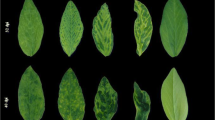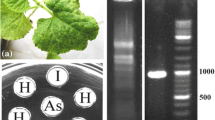Abstract
The paper gives more detailed characteristics of Arabis mosaic virus (AMV) and tomato bushy stunt virus (TBSV) isolated from lilac, the latter being identified in lilac (from plants suffering from yellow ring disease) for the first time. The isolate of TBSV from lilac, from which an antiserum with a titre of 1024 was prepared, is closely related to the artichoke strain. Information is given about two types of ringspot disease and about chlorotic ringspot of lilac. Whereas in the leaves of lilac suffering from ringspot disease (of ring mosaic type) the presence of AMV was demonstrated, the sap transmission from the leaves diseased with ringspot of linepattern (and wave-like mosaic) type failed; from the leaves affected by chlorotic ringspot a mixture of AMV and cherry leaf roll virus was identified. In addition, the polyetiological nature of “spring” mosaic and necrotic mosaic of lilac, in which bacteriumPseudomonas syringae van Hall, was found is dealt with. The TBSV was also identified in the isolate of necrotic mosaic.Additional index words: Lilac ringspot, chlorotic ringspot, yellow ring, “spring” mosaic, necrotic mosaic, cherry leaf roll virus,Pseudomonas syringae van Hall.
Similar content being viewed by others
References
Albrechtová, L., Chod, J., Zimandl, B.: Nachweis des Tomatenzwergbusch-Virus (Tomato bushy stunt virus) in Süsskirschen, die mit virösem Zweigkrebs befallen waren. - Phytopathol. Z.82: 25–34, 1975.
Harrison, B. D., Nixon, H. L.: Purification and electron microscopy of three soil-borne plant viruses. -Virology12: 104–117, 1960.
Huttinga, H., Mosch, W. H. M.: Lilac ring mottle virus: a coat protein-dependent virus with a tripartite genom. -Acta Horticult.59: 113–118, 1976.
Chod, J., Polák, J., Novák, M.: Untersuchungen über dasPelargonium leaf curl virus in der Tschechoslowakei. - Zentralbl. Bakt. etc. II. Abt.127: 676–682, 1974.
Kegler, H., Opel, H.: Ein verbessertes Verfahren zum Nachweiss von Bingfleckenviren der Kirsche mit krautigen Testpftanzen. - Albrecht Thaer Arch.7: 237–244, 1963.
Kegleb, H., Richter, J., Schmidt, H. B.: Untersuchungen zur Identifizierung und Differenzierung des Blattrollvirus der Kirsche (cherry leaf roll virus). - Phytopathol. Z.56: 313to 330, 1966.
Klement, Z.: Rapid detection of the pathogenicity of phytopathogenic pseudomonads. - Nature199: 299–300, 1963.
Kochman, J. H., Kowaiska, B., Szymanska, B.: Untersuchungen über Virosen des Flieders (Syringa vulgaris L.) und des Ligusters (Ligustrum vulgare L.). - Phytopathol. Z.51: 333 to 350, 1964.
Martelli, G. P., Quacquarelli, A., Russo, M.: Tomato bushy stunt virus. - C.M.I./A.A.B. Descriptions of Plant Viruses. No. 69, 1971.
van der Meer,F. A.: Observations on lilac ringspot. - Acta Hortieult.59: 105–111, 1976.
van der Meer, F. A., Huttinga, H., Maat, D. Z.: Lilac ring mottle virus: isolation from lilac, some properties, and relation to lilac ringspot disease. - Neth. J. Plant Pathol.82: 67–80, 1976.
Novák, J. B.: [Viruses in the familly ofOleaceae.] In Czech. - Preslia30: 365 (Abstr.), 1958.
Novák, J. B.: [Transmission and dissemination of virus diseases on some woody plants.] In Czech. - Sbornik Vysoké školy zemědělskě (Praha)1966: 471–484, 1966.
Novák, J. B.: Investigation of virus diseases of lilac. - In: Proceedings of the 6th. Conf. of the Czechoslovak Plant Virologists. Olomouc 1967. Pp. 289–299, 1969.
Novák, J. B., Brabencova, M., Lanzova, J.: [Serological diagnosis of bacteriaPseudomonas syringae van Hall. and its practical use.] In Czech. - In: Sbornik Vysokě skoly zemědělskě, Fak. agron. (Praha), řada A, díl 2,1976: 193–203, 1976.
Novák, J., Lanzová, J.: [Serological identification of cherry leaf roll virus on some woody plants in Czechoslovakia.] In Czech. - Sbornik Vysoké školy zemědělské, Fak. agron. (Praha), řada A,1974: 175–182, 1974.
Novák, J. B., Lanzova, J.: Etiology of two virus diseases of lilac (Syringa vulgaris L.) occurring in Czechoslovakia. - Biol. Plant.17: 226–227, 1975a.
Novák, J. B., Lanzová, J.: [On the etiology of cherry detrimental canker.] In Czech. -Sborník Vysoké školy zemědělské, Fak. agron. (Praha), řada A, díl 3,1975: 205–223, 1975b.
Novák, J. B., Lanzová, J.: Identification of alfalfa mosaic virus and tomato bushy stunt virus in hop (Humulus lupulus L.) and grapevine (Vitis vinifera subsp.)sativa (Dc./Hegi) plants in Czechoslovakia. - Biol. Plant.18: 152–154, 1976.
Novák, J. B., Lanzová, J.: Identification of tomato bushy stunt virus in cherry and plum trees showing fruit pitting symptoms. - Biol. Plant.19: 234–237, 1977.
Scmhelzer, K.: Untersuchungen an Viren der Zier- und Wildgeholze. 7. Mitteilung. - Phytopathol. Z.67: 285–326, 1970.
Smolák, J., Novák, J. B.: [Virus diseases of lilac] In Czech. - Ochrana Rostlin (Praha)23: 285 to 304, 1950.
Author information
Authors and Affiliations
Rights and permissions
About this article
Cite this article
Novák, J.B., Lanzová, J. Purification and properties of arabis mosaic and tomato bushy stunt viruses isolated from lilac (Syringa vulgaris L.). Biol Plant 19, 264–271 (1977). https://doi.org/10.1007/BF02923127
Received:
Published:
Issue Date:
DOI: https://doi.org/10.1007/BF02923127




